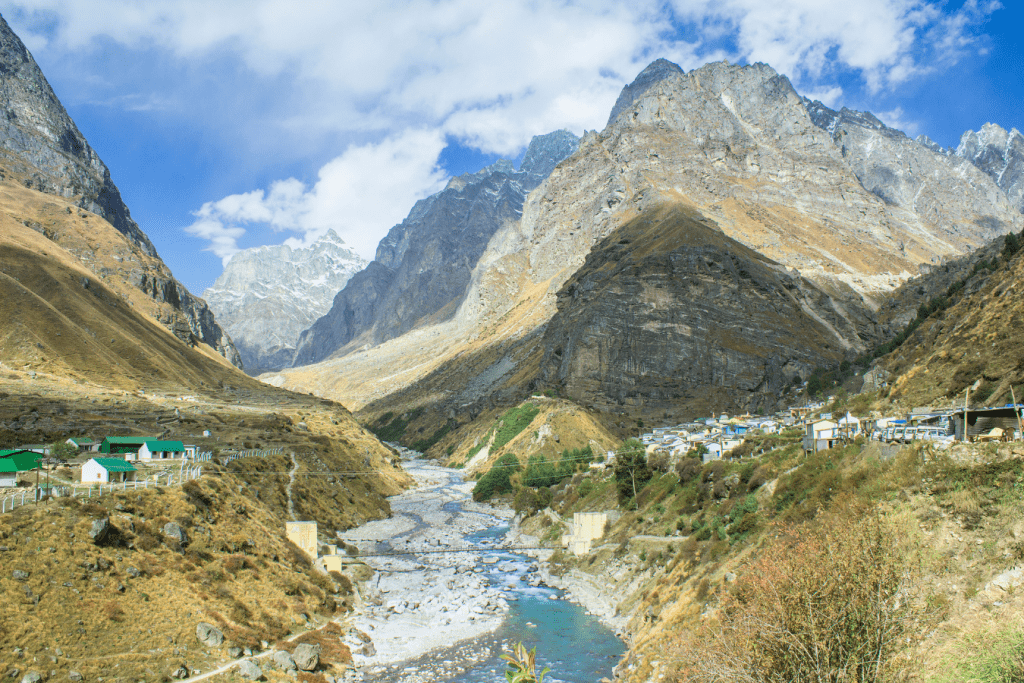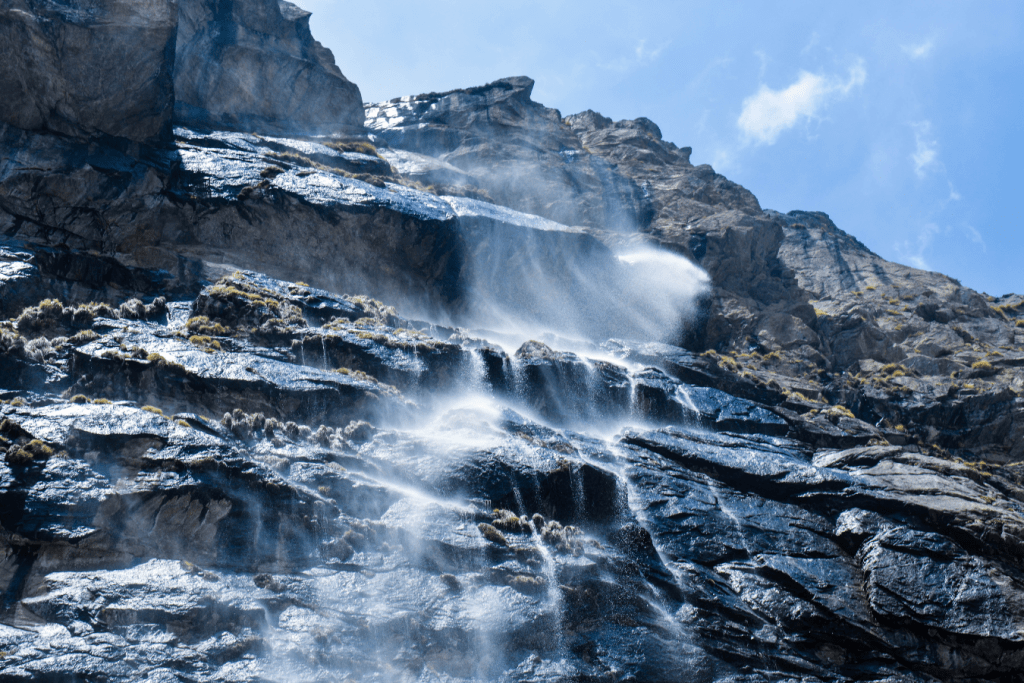Badrinath, high up in the Garhwal Himalayas of Uttarakhand, is more than just a place—it’s a feeling. Surrounded by snow-covered mountains and the calm flow of the Alaknanda River, Badrinath is where nature and spirituality come together in the most beautiful way.
Many people visit Badrinath as part of the Char Dham Yatra—the four sacred places that include Badrinath, Kedarnath, Gangotri, and Yamunotri. Others come after visiting some of the 12 Jyotirlingas, where Lord Shiva worshipped in his most powerful forms. Some travelers are here for devotion, some for peace, and some just to feel the magic of the Himalayas.

In this blog, we’ll take you through everything you need to know before visiting Badrinath—from how to get there and what to see, to the food you should try and the best time to visit.
Best Time to Visit Badrinath
Choosing the right time to visit Badrinath is essential, not just for comfort but also for safety. The temple is located at an altitude of over 10,000 feet, which means it experiences extreme weather for most of the year. The ideal time to visit is during the summer months of May to June and again in September to October, just after the monsoon season.

These months offer relatively stable weather and scenic beauty at its peak. July and August should generally be avoided due to heavy rainfall and the risk of landslides, which can disrupt travel plans. So, if you want a smooth journey and a peaceful darshan at the temple, planning your trip within these windows is highly recommended.
Temple Timings You Should Know
If you’re planning to participate in rituals or catch a glimpse of the deity, being familiar with the daily temple schedule is very important. The Badrinath Temple usually opens at 4:30 AM with the Abhishek Puja, a serene and powerful ceremony that starts the day. The temple then remains open until around 1:00 PM, after which it closes for a few hours. In the afternoon, it reopens at 4:00 PM and continues till about 9:00 PM, allowing pilgrims to participate in the evening Aarti.
However, these timings can vary slightly depending on the season and temple authorities, so it’s always wise to check the updated schedule beforehand. Also, keep in mind that queues can be long during peak season, so reaching early will give you a better experience.
How to Reach Badrinath Temple
Reaching Badrinath can be a journey in itself, especially considering its high-altitude location and remote surroundings. But with better roads and improved connectivity, the journey has become far more accessible in recent years.
Travel Options:
- By Air: The closest airport is Jolly Grant Airport in Dehradun, which is about 310 kilometers from Badrinath. From there, you can hire a cab or board a bus to continue your journey.
- By Train: If you prefer rail travel, the nearest major station is Rishikesh, located roughly 295 kilometers away. Haridwar is another option, slightly farther but more connected to major cities.
- By Road: The most common way to reach Badrinath is via road. Buses and taxis are readily available from Rishikesh, Haridwar, and Dehradun. The route takes you through breathtaking mountain terrain, but the journey can be long and winding. Also, travelers prone to motion sickness should come prepared.
So, whether you’re flying in from another state or starting your journey from a nearby hill town, there are multiple ways to get to Badrinath. However, always check road conditions and weather updates before you go, especially during the monsoon season.
The Story of Badrinath: Where Lord Vishnu Found Peace
A long time ago, high in the Himalayas, there was a quiet and beautiful place near a river called the Alaknanda. The air was fresh, the mountains covered in snow, and everything felt calm. This is where the story of Badrinath begins.
It is believed that Lord Vishnu, the protector of the universe, wanted a peaceful place to rest and meditate. So, he came to this cold and quiet part of the mountains. He sat under a tree called Badri and began to meditate. The weather became very cold, and snow started to fall. But Lord Vishnu did not move—he stayed deep in meditation.
Then, Goddess Lakshmi, who loved him very much, saw this. She didn’t want him to suffer from the cold. So, she turned herself into the Badri tree and stood over him like a cover to protect him. Because of this, Lord Vishnu was called Badrinarayan, and the place became known as Badrinath.

Many years later, in the 9th century, a great saint named Adi Shankaracharya came to this area. He was taking a bath in the hot spring near the river, known as Tapt Kund, when he found a special black stone in the water. It was not just a stone—it was the idol of Lord Badrinarayan.
So, he carefully took the idol and first kept it in a small cave. But he wanted more people to come and pray here. That’s why he built a proper temple and placed the idol inside. From then on, Badrinath Temple became a very important holy place.
Even today, when you visit Badrinath, you can feel that same peace in the air. The mountains, the river, and the temple all tell the story of Lord Vishnu’s time here—a story of love, devotion, and quiet strength.
Don’t Miss These Attractions Near Badrinath Temple
While Badrinath Temple is undoubtedly the main attraction, the surrounding region is full of fascinating places that are worth exploring. These sites are steeped in mythology and natural beauty, offering a perfect mix of spirituality and sightseeing.
1. Tapt Kund
Located right below the temple, this natural hot spring is where devotees bathe before entering the temple. The water is surprisingly warm even during freezing winters and is believed to have medicinal properties.
2. Neelkanth Peak
Standing tall behind the temple, this majestic snow-clad mountain glows beautifully at sunrise. It’s often called the “Garhwal Queen” and is a paradise for photographers and nature lovers.
3. Mana Village
Just 3 km from Badrinath, Mana is known as the last village of India before the Indo-Tibetan border. But it’s more than just a geographical landmark—it’s steeped in mythology and home to the Vyas Gufa and Ganesh Gufa, caves associated with the writing of the Mahabharata.
4. Charan Paduka
A short trek from the temple leads to a rock that has what are believed to be the footprints of Lord Vishnu. The climb is a bit steep, but the views and spiritual ambiance are worth it.
5. Vasudhara Falls
For the adventurous, a trek of around 9 km will take you to this stunning waterfall. Surrounded by towering cliffs and silence, Vasudhara is not just a visual treat but also a place for quiet reflection.
So, whether you’re seeking natural beauty or spiritual depth, these nearby attractions will add layers of richness to your trip.

Savor Local Flavors: Badrinath Cuisine
When in Badrinath, don’t miss the chance to try the local Garhwali cuisine, which is simple yet incredibly flavorful. Due to its religious significance and high altitude, the town mostly serves vegetarian food, but that doesn’t mean it lacks variety.
Must-Try Dishes:
- Aloo Ke Gutke – A spicy preparation of boiled potatoes, often served with puri or rice.
- Kandali Ka Saag – Made from a wild green leaf found in the Himalayas, this dish is rich in flavor and nutrients.
- Chainsoo – A protein-rich dish made with roasted black gram flour and cooked in mustard oil.
- Mandua Roti – This flatbread made from finger millet and goes perfectly with saag or lentils.
You’ll also find plenty of local tea stalls offering herbal and masala chai, perfect to warm you up in the chilly weather. So, while food might not be the main attraction in Badrinath, it definitely adds to the overall experience.

Conclusion
Visiting Badrinath is not just about going to a temple—it’s about feeling peace, faith, and the beauty of the mountains all at once. Some people come here as part of the Char Dham Yatra or after visiting the 12 Jyotirlingas, while others come just to enjoy the nature and calm.
So, before you go, it’s helpful to know the best time to visit—May to June or September to October are perfect. These months offer good weather and safer roads. Also, knowing the temple timings will help you take part in the early morning pujas and the beautiful evening aarti.
Then comes the journey itself. You can get to Badrinath by air, train, or road. The roads may be long and winding, but the views are amazing. Still, make sure to check weather updates, especially if you’re traveling during the rainy season.
But Badrinath isn’t only about the temple. It also holds a deep story of Lord Vishnu and how he came here to meditate. Places nearby, like Mana Village, Tapt Kund, and Vasudhara Falls, also add to the spiritual and natural charm of the trip.
And yes, don’t forget to try the local food. Even though it’s all vegetarian, dishes like Aloo ke Gutke and Mandua Roti are tasty and warm you up in the cold weather.
In the end, whether you’re coming for spiritual reasons, adventure, or just to enjoy the peaceful mountains, Badrinath has something special for everyone. So, pack your bags, wear something warm, and get ready for a journey that you’ll never forget.
Because Badrinath isn’t just a place—it’s a feeling that stays with you.